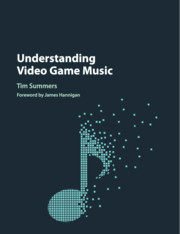Book contents
- Frontmatter
- Dedication
- Contents
- List of Figures, Musical Examples and Tables
- Foreword
- Acknowledgements
- Introduction: Beyond the Candelabrum
- PART I ANALYSING VIDEO GAME MUSIC
- PART II CRITICAL PERSPECTIVES
- Epilogue: Fun, Play and Music
- Appendix: How to Hear a Video Game: An Outline
- Bibliography
- Ludography
- Index of Games
- General Index
Epilogue: Fun, Play and Music
Published online by Cambridge University Press: 05 September 2016
- Frontmatter
- Dedication
- Contents
- List of Figures, Musical Examples and Tables
- Foreword
- Acknowledgements
- Introduction: Beyond the Candelabrum
- PART I ANALYSING VIDEO GAME MUSIC
- PART II CRITICAL PERSPECTIVES
- Epilogue: Fun, Play and Music
- Appendix: How to Hear a Video Game: An Outline
- Bibliography
- Ludography
- Index of Games
- General Index
Summary
[A]bove all, video games are meant to be just one thing – fun. Fun for everyone.
– Satoru Iwata, President of Nintendo, 2002–2015I began this volume by suggesting a link between play as it applies to video games and play in the context of music. In the intervening chapters we have encountered many different ways in which music is part of the way that gamers play games – from building the worlds and realities that are played with, to the communication of information useful for succeeding at winning the game, or, as in the last chapter, as part of exerting musical agency. To conclude this book, I wish to examine this common playful impulse further and try to understand why the combination of music and gameplay should be quite so significant.
As one might expect from a nebulous phenomenon, play has been theorized in a great multiplicity of ways. Psychologists, philosophers, game designers, sociologists and educationalists have all proposed different formulations of play. Common to nearly all examinations of play are three recurring components:
• some notion of rules, parameters or external forces that serve as boundaries or frames for play,
• creativity within those given rules/parameters/forces and
• a distinct mood or attitude of play.
These same three properties can be observed across the spectrum of scholarly definitions and descriptions of play, shared even between different disciplinary perspectives. Biologists Patrick Bateson and Paul Martin, as part of their argument that ‘[p]lay enables the individual to discover new approaches to dealing with the world’, describe the factors outlined above, respectively, as the environment, novel solutions to dealing with the world, and playfulness, a ‘positive mood state that facilitates and accompanies’ the kind of play that generates these novel solutions. Sociologist Thomas Henricks characterizes these same three issues as ‘external objects’, ‘a scheming or manipulative stance of subjects toward external objects’ and the ‘wave of sensations’ during play, while cultural historian Johan Huizinga defines them as ‘rules’, ‘voluntary activity or occupation’ and ‘a feeling of tension, joy and the consciousness that it is “different” from “ordinary life”’.
In this final category, of the ‘mood or attitude’ of play, Huizinga also stressed the importance of fun of play, claiming that it is the ‘fun-element that characterizes the essence of play’.
- Type
- Chapter
- Information
- Understanding Video Game Music , pp. 201 - 207Publisher: Cambridge University PressPrint publication year: 2016



